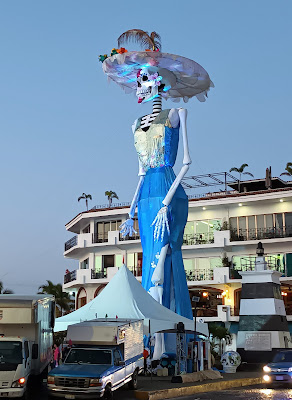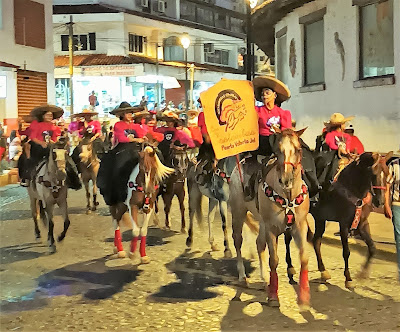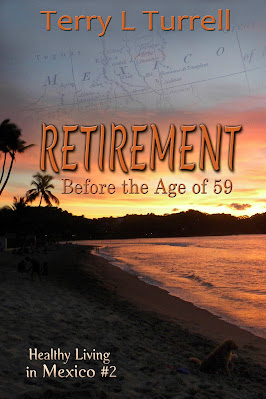Walking in México can be Dangerous
Careful! Don't Step Off the Curb Here!
Walking
in México can be dangerous—but not for the reasons you might think. It’s the
obstacles in the sidewalks and streets that you need to watch for constantly because there are many. I’ve included “Wheelchairing” in this because
now that my husband, Jon, sometimes uses a wheelchair, we’ve learned that there
are even more obstacles, ones we had previously overlooked.
The Sidewalk Ends Abruptly Without a Warning
Watch
for obstacles constantly while walking. This might seem obvious, but I’ve seen too
many tourists with new casts on their arms or ankles. Bleeding knees and black eyes are all-too-common among newcomers, too. No, it’s not from being
mugged. Stumbling, tripping, and falling can easily happen in México and there’s no one to
blame. The belief in this country is that if you fall and hurt yourself on the sidewalk, it’s the
sidewalk’s fault.
Everyone
is responsible for themselves here. So, to help keep yourself safe, here are 7
common hazards to watch for when walking or “wheelchairing”.
1.
Tripping Hazards
Beware of Bent, Damaged Drainage Grates in the Middle of the Sidewalk!
Tripping hazards come
in more shapes and forms than you can imagine. And they pop up in the most
unexpected places, even walking along a popular tourist Malecón. It’s easy to
become so distracted by all of the amazing views in México that you don’t
see the danger your feet are about to encounter.
Bolts are Left Sticking Up When Signposts are Removed--Ow!
This Toe-Stubber is Right at the Crosswalk!
Abandoned Raised Concrete Slabs in a Walkway are Common
These are just a few examples of the many tripping hazards for
pedestrians. We now understand how abruptly these obstacles can jarringly bring
a wheelchair to a halt, too.
2. Crossing Bike
Lanes Next to Walkways
Look Both Ways Before Crossing Bike Lanes!
Once, I stepped into this bike lane without looking when I crossed
from the sidewalk to the street to get on the bus! Fortunately, there weren’t any
bicycles coming. Bicyclists travel fast in México! Be aware that they travel on
sidewalks and streets, as well, so always be on the lookout for bikes and motorcycles. And they sometimes ride against traffic or the wrong way on a one-way street, so look both ways!
3. Steep
Ramps Can be Slippery, Especially if Damp or Sandy
There are No Slope or Width Requirements for Ramps
Stepping onto a steep ramp can be dangerous, especially if it
is damp or has a film of sand on the surface. I once stepped onto a tiled ramp
that had a film of dust on it, my foot slipped out from under me, and down I
went—fast and hard! Taking a wheelchair down a narrow, steep “Handicap” ramp
can be especially treacherous. This one is in the middle of the block, drops onto the rough cobblestone road, and has no ramp up to the sidewalk on the other side of the street.
4. Uneven
Step Heights and Treads, Double-Step High Curbs
Watch that Extra Unpainted Step by the Taxi Bench, Too!
This photo shows multiple hazards that make this corner
especially dangerous. I saw one young man try to quickly hop up the high double-step
curb, trip, and nearly land on his face. Fortunately, he had quick reflexes and was fine—others are
not so lucky. The hidden steps, uneven stair treads, and broken concrete add to
the risk of corners like this one. I've watched people fall going down unseen steps just as often as walking up! Be careful.
And in a wheelchair, good luck! Thankfully,
Jon is able to stand from his chair and walk down these steps.
Concrete Humps On the Handrail Side can Cause Stumbling
Puerto Vallarta has plans to make sidewalks accessible to all,
but some areas of Old Town still need improvement. High, broad, uneven steps and no
ramp as shown in this photo make some businesses inaccessible for those in
wheelchairs.
5. Trees
in the Middle of Sidewalks and Plant Cut-Outs in the Concrete are Possible Stumbling
Points
Someone Tried to Repair this Broken Planter Area, But...
Trees are Protected Here, Even When Taking Over the Sidewalk
Trees take priority in México, which is overall a good thing
for the environment and the appearance of cities. Just be aware that trees are
often growing in the middle of the sidewalks with little room to maneuver
around them. Also, the edging of the concrete cut-out for the tree may be
broken, raised, or sunken, creating a trip-and-fall hazard. Tree roots sometimes extend into the sidewalk and lift the concrete. Beware, be aware.
6. Cobblestone
Streets, Especially with Missing Stones and Loose Gravel
Loose Stones, Missing Stones, and Missing Concrete
Many streets in Mexican cities are paved with cobblestone or
other types of pavers. I love the old-world feel, but these streets take some practice
to walk on without twisting an ankle. If stones are loose or missing, a hole is
left that is even more treacherous. Stepping wrong on sand and gravel in the streets can cause your feet to fly right out from under you. I have first-hand experience with that!
7. Pedestrian
Bridges are Wicked to Cross but Sometimes Necessary
Wild Motion plus Protruding Rebar and Wire Fencing
Suspended walking bridges like this one are scarier to cross
than they look. And they’re more common in México than you might think—we have
to walk on this one to cross the Cuale River to our Zumba class on the Isla
Cuale in Puerto Vallarta. As soon as you begin walking on this bridge, it
begins to bounce and sway. If more than one person is walking, their differing
cadences cause the bridge to dip and dance in three directions. On top of that,
the curled rebar and bent wires at the base of the chain-link fencing will cut
into your calf if you get too close. We usually end up laughing at ourselves,
walking as though we are drunk, even while holding onto the fence.
And there’s
often a guy with a motorcycle patiently waiting at the other end for the bridge
to clear so he can walk his moto across. The moto will barely fit
side to side, so no pedestrians can be in the way. The locals know to clear the
bridge and give the moto the right of way when it’s his turn—we follow their
example. Another Lesson Learned...
7 Safety Suggestions for Walking and “Wheel-chairing” in México (Part 2 will be published next week)
Have you read my latest book in the Healthy Living in Mexico series, Living in Mexico More Lessons Learned? Available on Amazon worldwide, it's free with kindleunlimited.
Living in Mexico
More Lessons Learned
I invite you to SIGN UP for my Healthy Living and Traveling in Mexico Newsletter, published monthly with stories about our latest adventures,
my recent blog articles, and news about my books. Thank you for reading my blog articles, newsletters,
and books. As a self-published author on Amazon worldwide, I love it when
readers leave a brief review of my books. Check out my Amazon Author Page to see all of my books.
Happy reading and traveling!
Terry





























































